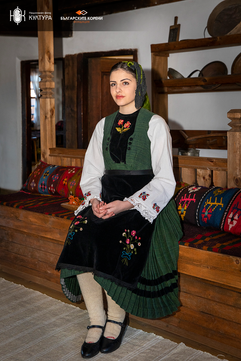Festive "geziya" (dziziya) from Razlog, from the first decades of the twentieth century
- Грозделина Георгиева-Саватинова

- Jul 8, 2021
- 3 min read
Updated: Nov 4, 2021
The upper garment - geziya ("dziziya") has a fitted upper part and 3 buttons on both sides of the bosom opening. A skirt with large pleats and a decoration in the lower part of 2 velvet black ribbons are sewn to it. The bosom is also made of velvet with colored embroidery in the center. It is a later development of the type of the “koshorest foustan”, but it, already a festive urban cloth is complemented by a velvet bosom embroidered with flowers. In this way additional colors are added and the femininity of the wearer is further emphasized, while at the same time impressing with its velvety festive “futa”.

The shirt (koshulya) with “zapeski”, which are characteristic for Razlog - tulips in red and blue and rich hand-knitted lace on the wide sleeves "prinka". Above there is a “futa” (apron) from velvet, embroidered with bouquets of flowers at the bottom and a finish with black factory lace.

She is veiled with a “shamiya”, called "parlenda", of fine silk and trimmed at the edges with hand-sewn or later with factory black lace. She is very much loved by young maidens and brides, as shown in one of the dance songs in Razlog: "Let's go, Yano, buy you a sham-shamiya; you to wear it, I to watch you ”. It was brought to the area by merchants from Trieste. The “shamiya” is in two colors - green and red, with printed flowers for decoration. Her role is to cover the hair, because in folk culture "unveiled woman is like naked." If young girls are allowed to be unveiled, with only a flower in their hair, then the married woman cannot afford it. Only family members can see the woman uncovered, but not outsiders.

On the feet with finely knitted one-color socks with embroidered on the toes and feet ornaments and shoed with leather shoes with a small heel.
This costume is a transitional stage to the urban style. Transient, because the cut of the outer garment is like a dress, but a shirt continues to be put below and an apron is saved on it, as in the traditional costume. The comfort and the bright beautiful colors, which stand out even more on the white shirt, make it a favorite garment for girls and married women. In the first half of the twentieth century, some of the age and socially defining elements of the costume are blurred. Sometimes on the square and at gatherings the young brides cannot be distinguished from the ready-to-marry girls - they are all in brightly colored dresses, high socks and "heeled shoes" with side fastening. Only the decoration of the brides with various ornaments - part of the bridal "mena" (gift) can show whether you have seen a girl or a married woman.

Veselina Angelinina frum Razlog put on the costume.
This costume is from the fund of the Historical Museum - Razlog.
The project "Study of the specifics and richness of national costumes from the Razlog region in the light of cultural diversity" is realized with the financial support of the National Culture Fund under the program "Cultural Heritage".
In fulfillment of the goals of the project we present some of the most beautiful traditional costumes, typical for the Razlog valley in the last 2 centuries.
We offer our sincere thanks to our hosts from the Historical Museum - Razlog, and to all local people who helped with the realization.
Special thanks to all participants and team members who took their time and with useful information, knowledge and valuable advice made possible the work on the project.
A reverence to the girls and boys from the town of Razlog, who stood in front of our camera and with their enthusiasm, youth and beauty revived for a new life the most beautiful costumes from old Mehomiya.




















Comments